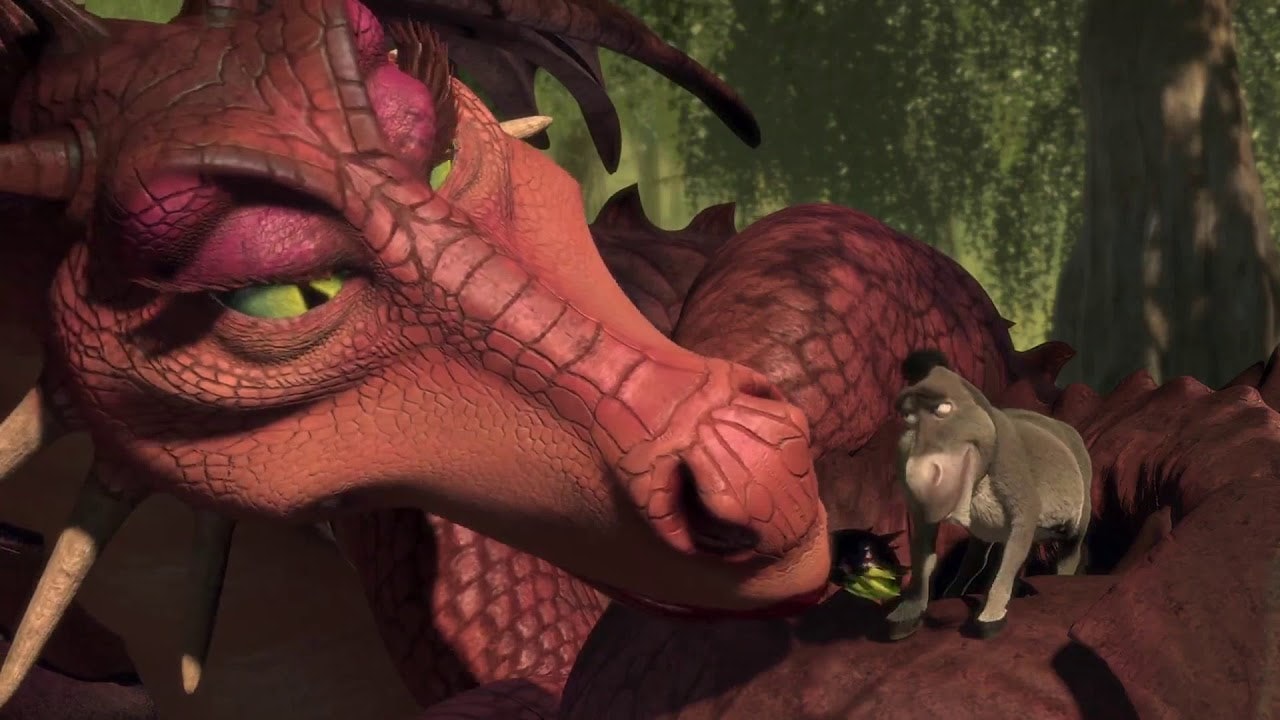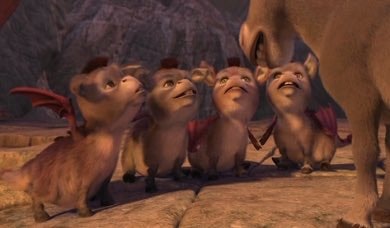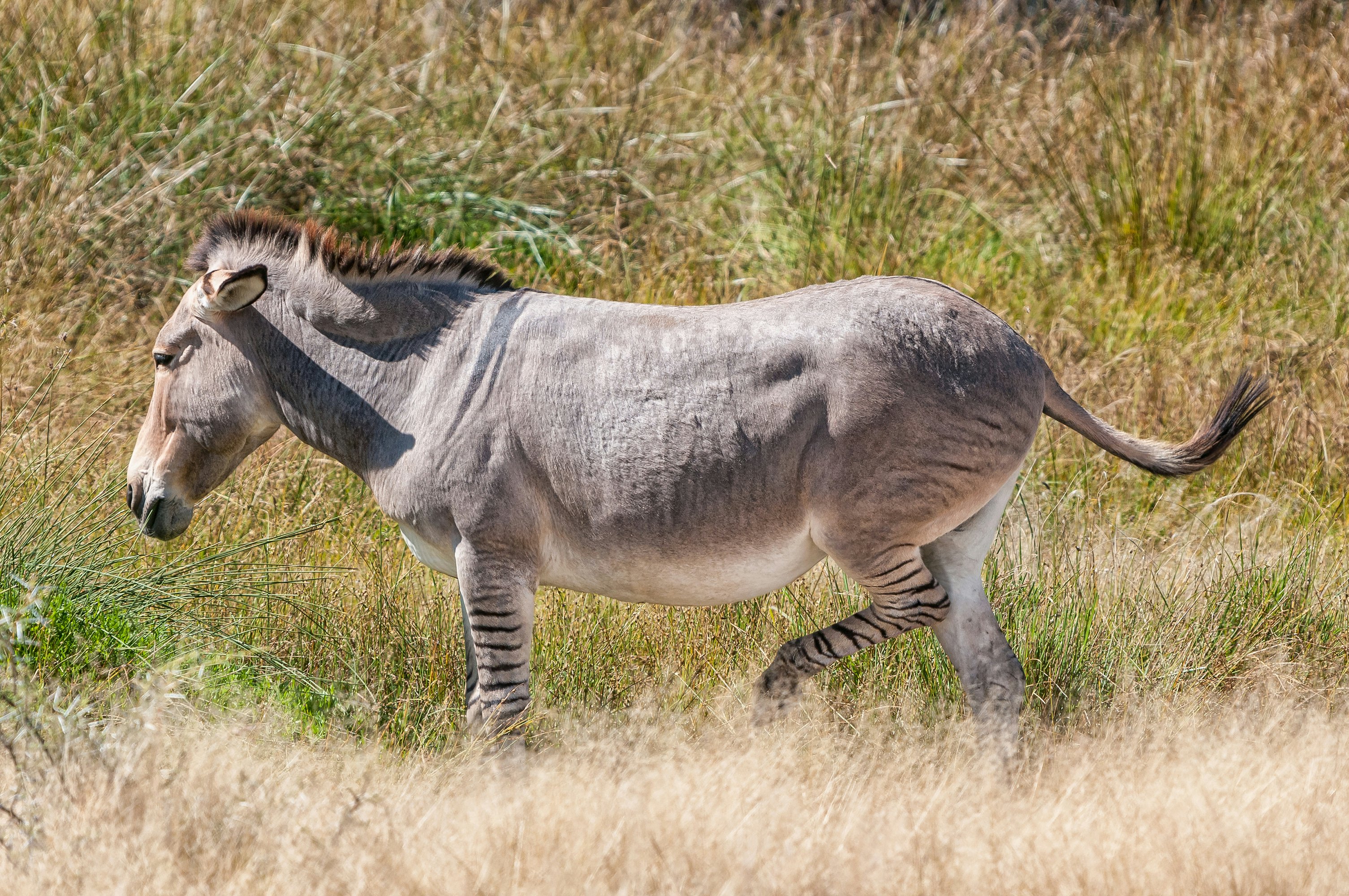
There’s a lot of weird stuff in Shrek 2 — the sequel to DreamWorks’ surprising smash hit about an ogre falling in love with a princess.
Amid the royal frogs, ogre farts, and angry in-laws in Shrek 2, there’s one detail that is undoubtedly weirder than the rest: the tumultuous love story between Shrek’s best buddy Donkey and Dragon. At the end of the movie, it’s revealed that Donkey and this dragon have mated, producing six hybrid flying donkey-dragon creatures known as “dronkeys.”
This may seem like a merely silly plot point in an already very silly film, but this bizarre donkey-dragon relationship actually reveals a serious scientific debate about the biology of hybrid animals and their role in the animal kingdom.
But could a donkey and a dragon really — well, hypothetically, since dragons aren’t real — mate and produce babies? According to Scott Taylor, Assistant Professor, Department of Ecology and Evolutionary Biology at the University of Colorado, the answer is a firm no.
“Two species as different as a donkey (mammal) and dragon (reptile?) could never produce offspring,” Taylor tells Inverse.
Still not convinced? Let’s take a closer look at the science of dronkeys.
Reel Science is an Inverse series that reveals the real (and fake) science behind your favorite movies and TV.
What are hybrid animals?

Many scientists interpret “hybrid” to mean a cross between two different species — the sperm of one species uniting with an egg of another species — resulting in offspring with a 50/50 mix of genetic information from both species. Some common real-life hybrids are mules, ligers, coywolves, and tigons.
So the dronkeys in Shrek 2 would definitely be hybrids. But hybrids can technically form even when two animals from the same species mate, so long as they’re from genetically different populations or subspecies. A hybrid could result from two different dog breeds — what we commonly refer to as a “mutt.”
“A hybrid is the offspring of a cross between two different forms,” James Mallet, a professor of Organismic and Evolutionary Biology at Harvard University, tells Inverse.
But Mallet explains how the line between hybrid and non-hybrid can very quickly be blurred over successive generations:
“A first-generation offspring of two species (like the dragon-donkey hybrids ‘dronkeys’ in the Shrek movies) is clearly a hybrid. But if those hybrids backcross to one of the parent species, when does it stop being a hybrid and start being the recipient species with a few genes from another species?”
Hybrid animals are different from so-called “chimeras,” which are “created when cells from one animal are transferred into another animal,” Insoo Hyun, Director of Research Ethics and Faculty Member in Harvard Medical School's Center for Bioethics, tells Inverse. A human receiving a transplant from another human would technically be a chimera, but not a hybrid.
It was previously thought that hybrid offspring resulting from interspecies breeding was not common in animals compared to plants, but “scientists are now becoming aware that it happens much more than previously thought,” Eva-Maria Geigl, paleogeneticist and head of research at Institut Jacques Monod in Paris, tells Inverse.
There’s even been some debate about whether humans constitute hybrids due to the prevalence of Neanderthal DNA in many of us. But it wouldn’t be accurate to call humans hybrids, experts say.
“Humans are not hybrids, but there is evidence of hybridization in our evolutionary history — (yes, with Neanderthals),” Taylor says.
Hypothetically, researchers could create hybrids of humans and animals in a lab “by uniting the sperm and eggs of humans and closely related apes,” according to Hyun.
But Hyun also adds, “There is no scientific reason for doing so, and I am not aware of anyone who actually believes this should be done.” So, there probably will be no human-ape babies in our near future.
Can a donkey and a dragon have babies?

In short: no. While dragons are fictional, we can assume for our purposes that dragons are some derivation of reptiles.
“Hybridization requires that the two species/subspecies are sufficiently closely related that the offspring is viable and that they are both in a position to encounter each other,” Alexandra Palmer, a research fellow at the University of Auckland’s School of Biological Sciences and Social Sciences, tells Inverse.
Donkey and Dragon meet the latter condition — close proximity — but not the former. Reptiles are not closely related to mammals, ergo, mating — and hybrid offspring — between an equine like Donkey and a reptile Dragon shouldn’t be possible, even in a fictional world where ogres exist. Mallet jokingly rates the chances of successful interbreeding between a donkey and a dragon as “one in ten billion.”
“A hybrid between donkeys and dragons is a fantastical idea since dragons are (presumably) egg-laying reptiles and not mammals like donkeys,” Hyun says, adding, “They would be too far apart evolutionarily speaking for this combination to work.”
Palmer agrees. “In the real world, any reptile certainly wouldn’t be able to successfully interbreed with an equine,” she says.
“A hybrid between donkeys and dragons is a fantastical idea”
But even if Shrek 2’s Donkey managed to mate with another non-dragon species, his offspring could very well be sterile.
In the real world, donkeys are not hybrid animals, but they can mate with horses to produce hybrid offspring, known as mules and hinnies. Hinnies are the offspring of male donkeys and female horses, and vice versa for mules. Mules and hinnies are both sterile, meaning they cannot naturally reproduce.
“The closer the parents of a hybrid are evolutionarily speaking, the higher the chances that the hybrid would be able to produce its own offspring,” Hyun says.
Are hybrid animals good for the world?

Compared to human-animal chimeras, there tend to be fewer ethical issues about hybrid animals — like zonkeys or mules — especially those bred by humans.
“Farmers have been creating hybrids for centuries, so hybrids are not shocking or new in a socially disruptive way,” Hyun says.
But there are also concerns about whether hybrids are good from an evolutionary perspective. Conservationists often raise concerns about non-native hybrid animals introducing invasive genes and wiping out a local species.
“We are almost always concerned about the short-term survival of the species in conservation, so we don't want to mess them up with invasive genes,” Mallet says.
While some scientific reports suggest that hybrids can contribute to species loss, other studies suggest they may be beneficial in adapting to circumstances like climate change by introducing new DNA to a local population. Recent reports suggest polar bears are mating with grizzlies to form “pizzly bear” hybrids as a result of climate change.
“Whether hybridization is good or bad is context-dependent,” Taylor says.
Taylor offers an example of humans introducing a non-native species — say, rainbow trout in Colorado. That species could “hybridize” or reproduce and form offspring with a native species like cutthroat trout, potentially leading to species loss.
“But hybridization can also provide genetic variation on which selection can act to produce new species — e.g., cichlids in Lake Victoria — or allow species to rapidly adapt to change,” Taylor adds.
Mallet agrees. “Hybridization is a natural process, and is neither ‘good’ or ‘bad.’ It just is,” he says.
Whether it’s good or bad, hybridization is here to stay — in both the real world and the fantasy world of Shrek 2.
Shrek 2 is streaming now on Netflix.







